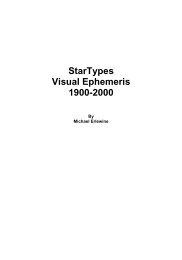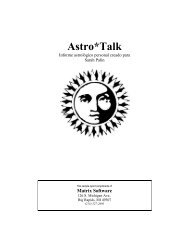The Art of Focus Stacking - Matrix Software
The Art of Focus Stacking - Matrix Software
The Art of Focus Stacking - Matrix Software
You also want an ePaper? Increase the reach of your titles
YUMPU automatically turns print PDFs into web optimized ePapers that Google loves.
Challenges in <strong>Focus</strong> <strong>Stacking</strong><br />
Histograms<br />
I have been photographing since around 1954 when<br />
my father loaned me his Kodak Retina 2A camera for<br />
a summer trip. Of course I was shooting film and dad<br />
paid for that and the developing. But the expense <strong>of</strong><br />
film and the fact that you had to wait days to find out if<br />
your photo even came out were great inhibitors to my<br />
photography experimentation. Back then I used a light<br />
meter to determine how to set my exposure but even<br />
that device (or my ineptitude) did not guarantee me a<br />
decent photo.<br />
In general I wouldn’t spend the money for film/ developing<br />
and I hated the guesswork involved in having<br />
no immediate visible feedback from each shot I took.<br />
With the advent <strong>of</strong> digital cameras all that changed.<br />
Now I can afford to shoot as much as I like and the<br />
LCD preview screen gives me instant feedback as to<br />
whether I am in or out <strong>of</strong> focus, whether I have too<br />
much or too little light, and so on. <strong>The</strong>re is one feature<br />
in these new cameras that is VERY important to have,<br />
and that is visible histograms that evaluate exposure.<br />
<strong>The</strong> RGB histograms amount to a 21st century light<br />
meter, one built into the camera itself.<br />
Using RGB histograms allows us to tell at a glance<br />
whether the photo we just shot is exposed properly<br />
for our purposes or whether it is too dark or too light.<br />
Histograms make it clear whether we have a lot <strong>of</strong><br />
clipping going on, which means we have lost photo<br />
information that can’t be retrieved later in Photoshop.<br />
This is something we really need to know, because<br />
if I spend an hour shooting an important subject only<br />
to find out later that all images were severely overexposed,<br />
it is a heartbreaker if I can’t repeat the shoot<br />
due to circumstances, etc.<br />
This is not the place to explain how best to use histograms.<br />
<strong>The</strong>re are dozens <strong>of</strong> good tutorials on using<br />
histograms on the web. Just note: when shopping for<br />
a camera, get one that does show you an RGB histogram.<br />
Since I don’t use automatic focus, shutter, or<br />
aperture, I would be lost without histograms.<br />
<strong>Focus</strong><br />
In <strong>Focus</strong> <strong>Stacking</strong>, auto-focusing is not used since<br />
auto focusing lets the camera decide on one and only<br />
one focus point, and that is that. In focus stacking we<br />
need many points <strong>of</strong> focus, and want to set each one<br />
ourselves, since the camera does not have an eye for<br />
beauty… yet. So you will be using manual focus for<br />
close-up and focus stacking.<br />
Camera Bodies<br />
<strong>The</strong> two leading makers <strong>of</strong> fine camera bodies are<br />
Canon and Nikon. Both companies make good cameras.<br />
I happen to like the Nikon workmanship and right<br />
now they are the best low-light cameras on the market,<br />
meaning they can work at relatively high ISO levels,<br />
i.e. work in low light with less graininess. Nikon also<br />
has (even according to Canon users) the best aut<strong>of</strong>ocus<br />
system and best flash system available. It is too<br />
bad that there is not a universal lens mount for DSLRs<br />
because once you start buying lenses for one brand,<br />
Nikon or Canon, it is very difficult to switch camera<br />
bodies since they are not interchangeable.<br />
Normal Lenses<br />
On 35mm format cameras (like many DSLRs) the<br />
50mm lens is “normal” and anything longer (60mm,<br />
90mm, 200mm, 500mm) is considered a telephoto lens<br />
and anything shorter (35mm, 24mm, 14mm) is considered<br />
as wide angle. Almost every photographer has a<br />
50mm lens and preferably a fast one… f/2.8 or better.<br />
Most photographers’ kits also have at least one wideangle<br />
lens and one telephoto lens. I mentioned earlier<br />
that the most popular macro lenses typically range<br />
from 60mm to 200mm, with 105mm being traditionally<br />
a popular length for macro photography. My favorite<br />
macro lens is 125mm.<br />
Camera Body Features<br />
Close-up and macro photography require a stable support<br />
such as a tripod and with focus stacking it is pretty<br />
much mandatory. An added feature that you might want<br />
to look for when buying a camera body is the ability<br />
lock the mirror up before a shot. With DSLR bodies<br />
typically, in order to see through the viewfinder to focus<br />
one has to have a mirror so that you can see out <strong>of</strong> the<br />
front <strong>of</strong> the lens. Yet when a picture is taken that mirror<br />
has to first be raised up out <strong>of</strong> the way, the photo taken,<br />
and the mirror lowered for the next shot. When the<br />
mirror is raised it slams into the top <strong>of</strong> the camera body<br />
and causes vibration which very <strong>of</strong>ten affects the photo<br />
being taken. <strong>The</strong> shock <strong>of</strong> the mirror bring raised reverberates<br />
through the camera while the shot is taken and<br />
causes the photo to be very slightly out <strong>of</strong> focus.<br />
This is especially important in close-up and macro<br />
photography, in particular when focus stacking. Higherend<br />
cameras have a setting that allows you to raise the<br />
mirror when you take a photo, wait for a second while<br />
the mirror is raised and the vibration vanishes, and<br />
then press the release button a second time to take the<br />
actual photo. This <strong>of</strong> course only works for still life or<br />
shots where action is not what you are after. This is a<br />
very important feature to have, if you can.<br />
80

















